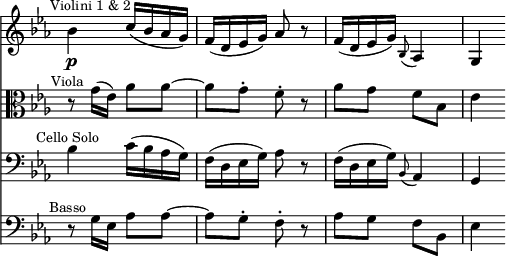to have been composed at Linz for Count Thun) coincides with the period in which he is considered to have been first strongly influenced by Haydn.
The influence of these two great composers upon one another is extremely interesting and curious, more especially as it did not take effect till comparatively late in their artistic careers. They both began working in the general direction of their time, under the influences which have been already referred to. In the department of symphony each was considerably influenced after a time by a special circumstance of his life; Haydn by the appointment to Esterház before alluded to, and the opportunities it afforded him of orchestral experiment; and Mozart by his stay at Mannheim in 1777. For it appears most likely that the superior abilities of the Mannheim orchestra for dealing with purely instrumental music, and the traditions of Stamitz, who had there effected his share in the history of the Symphony, opened Mozart's eyes to the possibilities of orchestral performance, and encouraged him to a freer style of composition and more elaborate treatment of the orchestra than he had up to that time attempted. The Mannheim band had in fact been long considered the finest in Europe; and in certain things, such as attention to nuances (which in early orchestral works had been looked upon as either unnecessary or out of place), they and their conductors had been important pioneers; and thus Mozart must certainly have had his ideas on such heads a good deal expanded. The qualities of the symphony produced in Paris early in the next year were probably the first fruits of these circumstances; and it happens that while this symphony is the first of his which has maintained a definite position among the important landmarks of art, it is also the first in which he uses orchestral forces approaching to those commonly employed for symphonies since the latter part of the last century.
Both Haydn and Mozart, in the course of their respective careers, made decided progress in managing the orchestra, both as regards the treatment of individual instruments, and the distribution of the details of musical interest among them. It has been already pointed out that one of the earliest expedients by which contrast of effect was attempted by writers for combinations of instruments, was the careful distribution of portions for 'solo' and 'ripieno' instruments, as illustrated by Scarlatti's and later concertos. In J. S. Bach's treatment of the orchestra the same characteristic is familiar. The long duets for oboes, flutes, or bassoons, and the solos for horn or violin, or viola da gamba, which continue throughout whole recitatives or arias, all have this same principle at bottom. Composers had still to learn the free and yet well-balanced management of their string forces, and to attain the mean between the use of wind instruments merely to strengthen the strings and their use as solo instruments in long independent passages. In Haydn's early symphonies the old traditions are most apparent. The balance between the different forces of the orchestra is as yet both crude and obvious. In the symphony called 'Le Matin' for instance, which appears to have been among the earliest, the second violins play with the first, and the violas with the basses to a very marked extent—in the first movement almost throughout. This first movement, again, begins with a solo for flute. The slow movement, which is divided into adagio and andante, has no wind instruments at all, but there is a violin solo throughout the middle portion. In the minuet a contrast is attained by a long passage for wind band alone (as in J. S. Bach's 2nd Bourrée to the 'Ouverture' in C major); and the trio consists of a long and elaborate solo for bassoon. Haydn early began experiments in various uses of his orchestra, and his ways of grouping his solo instruments for effect are often curious and original. C. F. Pohl, in his life of him, prints from the MS. parts a charming slow movement from a B♭ symphony, which was probably written in 1766 or 1767. It illustrates in a singular way how Haydn at first endeavoured to obtain a special effect without ceasing to conform to familiar methods of treating his strings. The movement is scored for first and second violins, violas, solo violoncello and bass, all 'con sordini.' The first and second violins play in unison thoughout, and the cello plays the tune with them an octave lower, while the violas play in octaves with the bass all but two or three bars of cadence; so that in reality there are scarcely ever more than two parts playing at a time. The following example will show the style:—

Towards a really free treatment of his forces he seems, however, to have been led on insensibly and by very slow degrees. For over twenty years of symphony-writing the same limited treatment of strings and the same kind of solo passages are commonly to be met with. But there is a growing tendency to make the wind and the lower and inner strings more and more independent, and to individualise the style of each within proportionate bounds. A fine symphony (in E minor, 'Letter I') which appears to date from 1772, is a good specimen of Haydn's intermediate stage. The strings play almost incessantly throughout, and the wind either doubles
